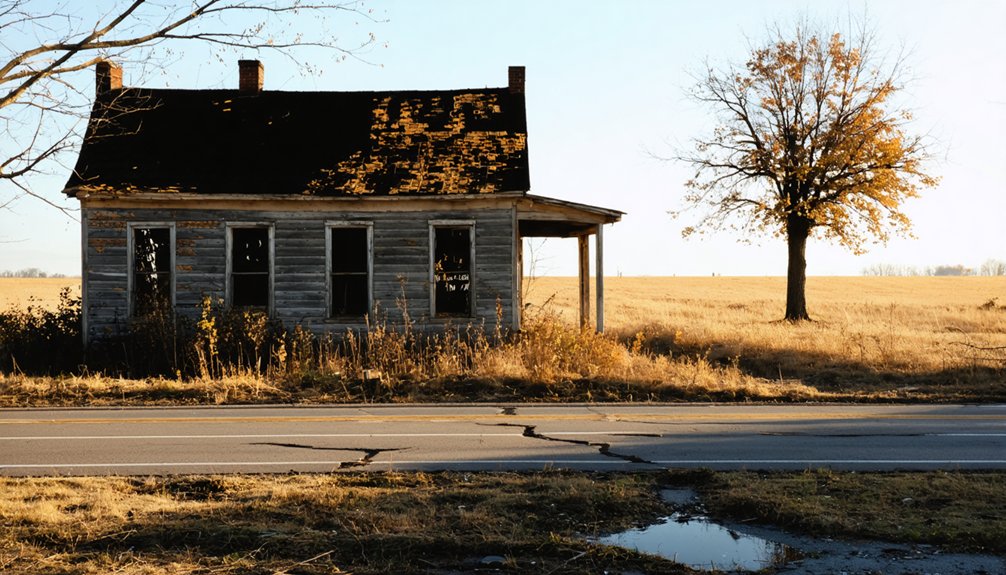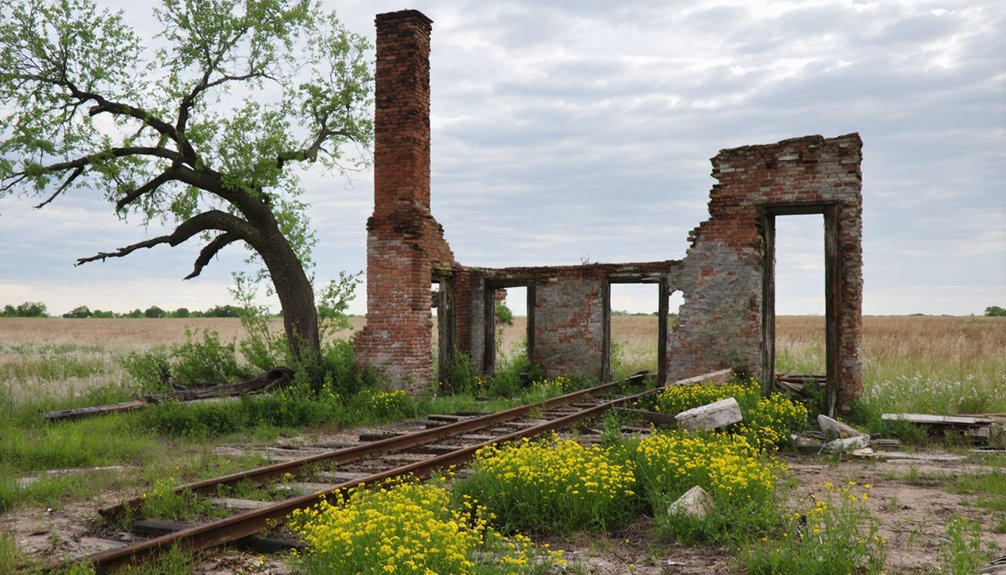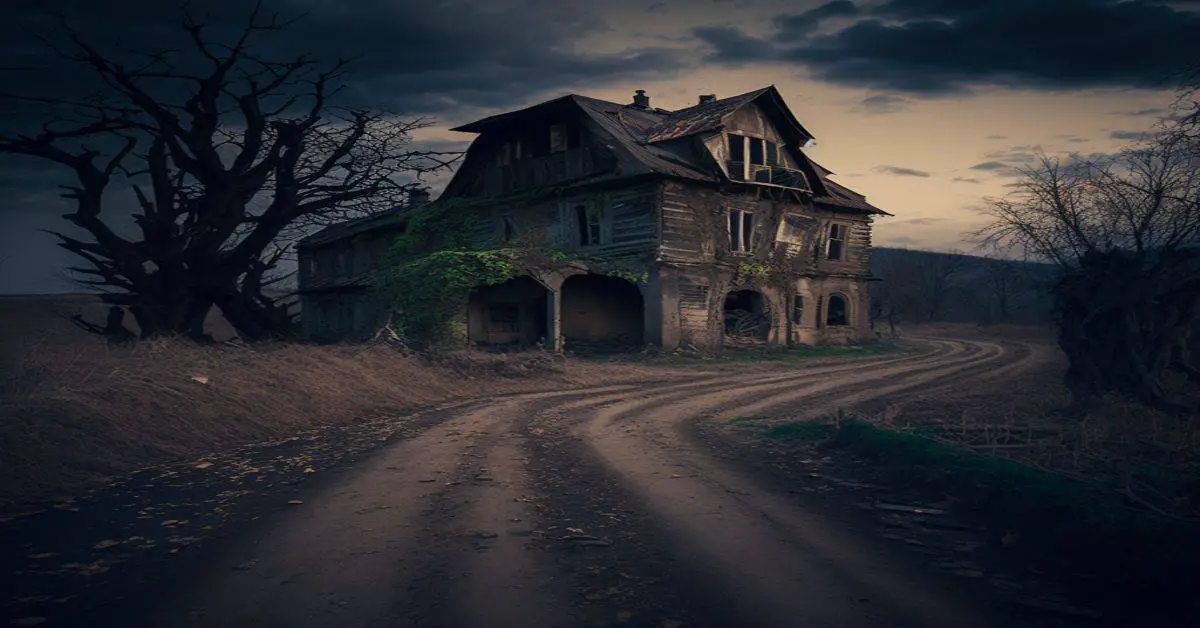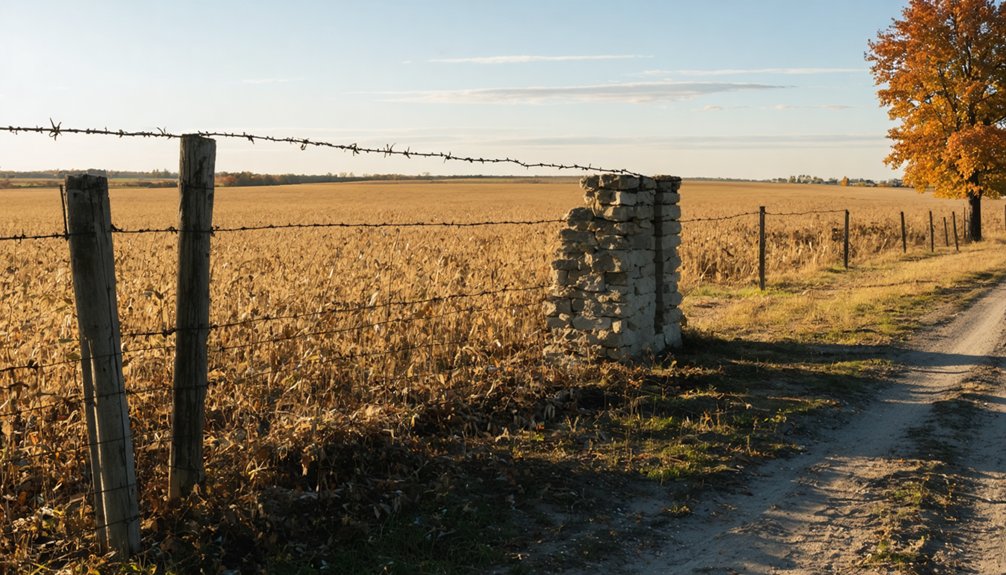You’ll find Tracy’s ghost town remains in Essex Township, Kankakee County, where it flourished briefly as a coal mining settlement in the 1860s. The town developed around the Illinois Central Railroad and Lone Rock mines, supporting about a dozen buildings and a hardy mining community. By 1900, depleted coal seams led to Tracy’s rapid abandonment, with its structures vanishing into the prairie landscape. The site’s forgotten stories of boom-and-bust paint a fascinating portrait of Illinois’ coal mining era.
Key Takeaways
- Tracy was a 19th-century Illinois coal mining town near the Illinois Central Railroad that flourished during the 1860s coal boom.
- The town consisted of about twelve buildings and housed miners working at the Lone Rock mines.
- After coal seams depleted around 1900, Tracy experienced rapid population decline, with residents abandoning their homes.
- The final closure of mining operations in 1971 led to 275 job losses and marked the end of Tracy’s industrial era.
- No structures remain at Tracy’s original site today, with the land reverting to prairie and leaving minimal historical documentation.
The Rise of a Coal Mining Settlement
While many Illinois coal towns emerged during the 1800s, Tracy’s establishment in Essex Township, Kankakee County, stood out for its strategic position near valuable coal seams and the Illinois Central Railroad.
You’ll find its origins deeply rooted in the northern Illinois coal boom of the 1860s, when major corporations seized opportunities to supply Chicago’s growing industrial needs.
The settlement quickly developed around a dozen buildings, primarily housing miners who worked the nearby Lone Rock mines and coke ovens.
After a strike in 1871, the mining company turned to convict labor, bringing in 104 prisoners to work the dangerous underground operations.
Like many mining communities, workers faced exploitation through company store prices, which were significantly higher than regular retail establishments.
Despite the company’s attempts to present the convict stockade as structured and humane, mining accidents remained a grim reality of daily life in Tracy’s coal-driven economy.
When the coal seam was depleted around 1900, the town quickly vanished, leaving behind only memories of its brief industrial existence.
Life Along the Illinois Central Railroad
The Illinois Central Railroad transformed life in Tracy and similar settlements through its extensive network of rails and spurs connecting the coal-rich regions to Chicago’s industrial heart.
You’d find these railroad connections weren’t just about moving coal – they shaped the very essence of town infrastructure and daily existence.
- You could hop aboard trains heading north to Chicago’s markets or south to Cairo’s river ports.
- Your community’s survival depended on the railroad’s commitment to maintaining spurs and stations.
- You’d witness European immigrants arriving to work the mines, brought by IC’s colonization efforts.
- Your town’s prosperity rose and fell with the railroad’s freight schedules and coal shipping demands.
These crucial rail links determined whether settlements like Tracy would thrive or fade into history once their coal seams ran dry. The railroad’s dedication to coal transport remained steadfast, continuing to use steam power until 1960 for moving freight across its network. With its 3,130 miles of track, the Illinois Central became the longest railroad in the world when completed in 1856.
Daily Existence in a Mining Town
Life in Tracy centered around the harsh realities of coal mining, where you’d find both free laborers and convicts toiling beneath the earth’s surface in dangerous conditions.
Your daily routines would revolve around long shifts underground, followed by rest in simple company-owned housing where you’d tend small vegetable gardens and livestock to supplement your family’s needs. The looming threat of acid mine drainage from abandoned shafts constantly endangered the town’s water supply.
Community interactions were limited and controlled by the mining company’s influence. You’d shop at the company store using credit against your wages, and Sunday religious services provided one of the few social outlets.
While free miners lived with their families in basic homes, convicts endured life in stockades. The town’s existence hung precariously on the coal seam’s productivity, and when it was depleted around 1900, Tracy’s community quickly vanished.
The Coal That Built Tracy
Deep beneath Illinois’ fertile prairie soil, Tracy’s rich coal seams fueled both local industry and Chicago’s rapid growth during the late 1800s.
Hidden beneath the heartland’s prairies, Tracy’s coal deposits powered the industrial engines of Illinois and Chicago’s Victorian-era expansion.
You’ll find that miners employed traditional shaft mining techniques to access these valuable deposits, using the “room and pillar” method to guarantee structural stability while extracting the coal. Early settlers in the region mined coal outcrops for blacksmithing and household needs before formal operations began. The coal seams reached depths of approximately 100 feet underground.
The mining operation’s success relied on four key elements:
- Strategic location along the Illinois Central Railroad for efficient transport
- Abundant coal seam deposits suitable for underground mining
- Available workforce, including immigrant laborers from Eastern Europe
- Growing demand from Chicago’s expanding industrial market
The coal seam’s eventual depletion around 1900 marked Tracy’s fate, transforming this once-bustling mining settlement into the ghost town you can explore today.
The exhausted mines stand as silent witnesses to Illinois’ industrial heritage.
A Community’s Brief Moment

While humble in size, Tracy embodied the quintessential Illinois mining settlement of the late 1800s, with roughly a dozen buildings clustered around its essential railroad spur northwest of Buckingham.
The community dynamics revolved entirely around coal extraction, with miners and their families occupying modest company housing near the mines. Like the tragic events at Cardiff’s mine explosions, Tracy faced its own share of mining dangers and difficulties. Similar to the peak population trends seen in Buda’s 1500 residents, Tracy experienced brief but significant growth during its mining heyday.
You’d have found a transient workforce moving through Tracy, as was typical of mining settlements during this era. Life centered on the Illinois Central Railroad connection, which served as both the town’s economic lifeline and physical anchor.
When the Mines Ran Dry
You’ll find Tracy’s story follows a familiar pattern of Illinois coal towns: a rapid boom followed by an equally swift bust when its coal seam ran dry around 1900.
The miners and their families departed almost overnight, leaving behind a dozen buildings that would soon vanish into the prairie landscape.
As shaft mining declined across Kankakee County through 1910, Tracy’s abandonment foreshadowed the fate of larger nearby settlements like Clarke City, where populations dwindled and local economies crumbled without the sustaining power of coal.
Mining Boom and Bust
As the coal mines around Tracy reached their peak production in the mid-20th century, few could have predicted the industry’s imminent decline. The Jones and Laughlin operation, which opened in 1950, employed advanced mining techniques but couldn’t escape the harsh realities that would soon plague Illinois coal country.
You’ll find the story of Tracy’s boom-and-bust cycle reflected in these critical turning points:
- Increased mechanization displaced traditional labor forces
- Growing labor disputes between miners and management strained operations
- High-sulfur content made Tracy’s coal less marketable under new regulations
- Depletion of accessible reserves by 1971 sealed the mine’s fate
When the mine finally closed its doors in 1971, it marked the end of an era for Tracy’s coal industry, leaving behind a community that would soon fade into Illinois’ growing collection of ghost towns. The shutdown resulted in 275 workers losing their jobs as the facility transitioned to alternative uses.
Abandoned Without Warning
Despite its strategic location along the Illinois Central Railroad, Tracy’s fate was sealed when its singular coal seam ran dry around 1900.
You would’ve witnessed an unprecedented mining displacement as families packed up and abandoned their homes virtually overnight. Without any alternative industries to fall back on, the town’s dozen or so wooden buildings emptied quickly, leaving behind a stark reminder of the region’s boom-and-bust mining cycle.
Unlike communities that showed resilience through economic diversification, Tracy’s complete dependence on coal extraction left it vulnerable to sudden collapse.
The town’s residents, mostly miners and their families, followed the mining frontier southward, seeking new opportunities in other coal towns.
Today, you’ll find little evidence of Tracy’s existence – its wooden structures and railroad infrastructure have vanished, leaving only memories of a town that disappeared without warning.
Life After Coal Collapse
When the coal seam ran dry in 1900, Tracy’s rapid transformation into a ghost town revealed the harsh realities of single-industry dependence.
Without economic diversification, you’d have witnessed the exodus of miners and their families, leaving behind a dozen empty buildings and abandoned railroad spurs.
The aftermath of Tracy’s collapse highlighted four key changes:
- Former residents scattered to nearby towns seeking new employment
- Agricultural activities expanded into previously industrial areas
- Railroad infrastructure fell into disrepair as shipping needs vanished
- Environmental concerns from abandoned mines persisted
While community resilience might’ve saved other towns, Tracy’s isolation and limited resources left few options for recovery.
The empty buildings stood as silent reminders of boom-and-bust cycles that defined Illinois’ coal country.
Vanishing Without a Trace
The complete disappearance of Tracy, Illinois stands as a textbook example of how quickly a mining settlement could vanish from both the landscape and historical record.
Today, you’ll find no remnants of the dozen buildings that once housed coal miners and their families. Like many ghost towns born from economic decline, Tracy faded into obscurity when its sole coal seam ran dry around 1900.
What makes Tracy’s case particularly striking is the total absence of physical evidence.
You won’t discover any surviving structures, archaeological findings, or even foundation stones at the site. The land has completely reverted to its natural state, with no visible markers of human habitation.
Even in archives and historical collections, Tracy’s existence is barely a whisper, documented only through scattered mentions in old railroad maps and local histories.
The Railroad’s Silent Spur

Railroad spurs often tell stories of forgotten places, and Tracy’s connection to the Illinois Central Railroad speaks volumes about its brief but essential existence.
The spur’s economic dependency on coal transport shaped every aspect of this small settlement’s destiny.
You’ll find Tracy’s railroad infrastructure was remarkably focused on a single purpose – moving coal from mine to market.
Here’s what made this spur significant:
- Connected directly to Illinois Central’s main line near Buckingham
- Supported rapid coal loading without passenger facilities
- Served as the lifeline for about a dozen miners’ homes
- Appeared prominently on Illinois Central’s 1892 map
When the coal seam ran dry around 1900, the spur fell silent.
Today, at 41°10′10″N, 88°14′02″W, you won’t find a trace of the tracks that once carried Tracy’s lifeblood to the world.
Legacy in Maps and Memory
While physical traces of Tracy’s railroad spur have vanished, its cartographic footprint endures through preserved maps and documents that tell its story.
You’ll find Tracy clearly marked on the 1892 Illinois Central Railroad map at 41°10′10″N 88°14′2″W, northwest of Buckingham in Kankakee County. This cartographic significance extends beyond mere coordinates – it’s preserved in ghost town archives, digital libraries, and historical journals that paint a vivid picture of Illinois’ mining heritage.
The town’s historical documentation lives on through mapping projects and GIS initiatives, which you can explore through the Digital Research Library of Illinois History Journal.
Though no buildings remain, Tracy’s mapped legacy continues to inform researchers and enthusiasts about the dramatic shifts in 19th-century settlement patterns driven by coal mining and railroad expansion.
Lessons From a Lost Town

Tracy’s rapid decline serves as a stark warning about the dangers of building an economy around a single extractive industry, as you’ll find the town completely vanished once its coal seam was depleted around 1900.
You can trace how the town’s fate was sealed by its failure to diversify beyond coal mining, despite having valuable railroad infrastructure that could have supported other industries.
The lessons from Tracy’s disappearance remain relevant today, showing why communities must plan for economic adaptability rather than relying solely on finite natural resources.
Dangers of Single Industries
The sudden demise of Tracy, Illinois offers a stark warning about the perils of economic monocultures in small towns. When you rely solely on a single industry, you’re building your community on a foundation of sand.
Tracy’s coal-dependent economy crumbled rapidly because it lacked workforce diversification and economic sustainability measures.
Consider these critical lessons from Tracy’s collapse:
- A specialized workforce becomes obsolete when the primary industry fails.
- Limited infrastructure investment restricts opportunities for economic pivots.
- Single-industry dependencies create an all-or-nothing scenario for survival.
- Lack of economic diversification eliminates community resilience.
You’ll find Tracy’s story eerily relevant today, as many modern communities still gamble their futures on dominant industries.
The town’s swift transformation from bustling coal center to abandoned prairie serves as a powerful reminder about the importance of building adaptable, multi-faceted local economies.
Planning for Economic Adaptability
Learning from abandoned communities like Tracy requires a clear-eyed examination of economic adaptability strategies that modern towns can implement.
You’ll find that economic resilience depends heavily on diversifying beyond a single industry well before resources deplete. This means investing in workforce training programs, building flexible infrastructure, and fostering community innovation through entrepreneurial support.
Your town’s survival hinges on adaptive planning that balances resource management with environmental sustainability.
Don’t wait until it’s too late – start developing alternative economic sectors now. Consider how you can transform existing assets into tourism opportunities, expand transportation networks, and cultivate diverse business ventures.
Frequently Asked Questions
Were There Any Major Mining Accidents or Disasters in Tracy?
While no major mining disasters occurred in Tracy itself, you’ll find the nearby 1909 Cherry Mine disaster, which killed 259 miners, sparked massive improvements in mining safety and disaster response protocols.
What Happened to the Mining Equipment After the Town Was Abandoned?
You’ll find that most mining equipment was abandoned and left to rust, though some was likely salvaged for scrap. Without historical preservation efforts, these remnants gradually deteriorated into the landscape.
Did Any Original Tracy Residents’ Descendants Remain in Kankakee County?
You can’t definitively confirm descendant stories, as there’s no explicit genealogical evidence tracking family connections of Tracy’s original residents in Kankakee County after the town’s abandonment around 1900.
What Was the Average Wage for Coal Miners in Tracy?
You’ll find coal miners in Tracy during the 1910s-1920s earned around $2.56 to $7.50 per day, matching regional averages. By 1926, miners typically made 77.9 cents per hour for hand-loading work.
Were There Any Attempts to Find Other Coal Seams Nearby?
Envision this: You won’t find records of any serious coal exploration after 1900. Despite advances in mining technology, companies didn’t pursue new seams once the original Colchester deposit ran dry.
References
- https://drloihjournal.blogspot.com/2022/09/lost-towns-of-illinois-tracy-illinois.html
- https://www.youtube.com/watch?v=93k0qtvzkn4&vl=en-US
- https://drloihjournal.blogspot.com/search/label/Lost Towns of Illinois
- https://bartonchronicle.com/a-visit-to-the-ghost-city/
- https://www.iheart.com/podcast/105-stuff-you-missed-in-histor-21124503/episode/six-impossible-episodes-us-ghost-towns-301955004/
- https://en.wikipedia.org/wiki/List_of_ghost_towns_in_Illinois
- https://grundycountyhistory.squarespace.com/s/Tracy-City-Coal-Miners-and-the-Convict-Labor-Lease-System.pdf
- https://www.eiu.edu/historia/Kernc2013SE.pdf
- http://www.illinoislaborhistory.org/labor-history-articles/early-days-of-coal-mining-in-northern-illinois
- https://www.imsif.com/history-of-mining-in-illinois/



